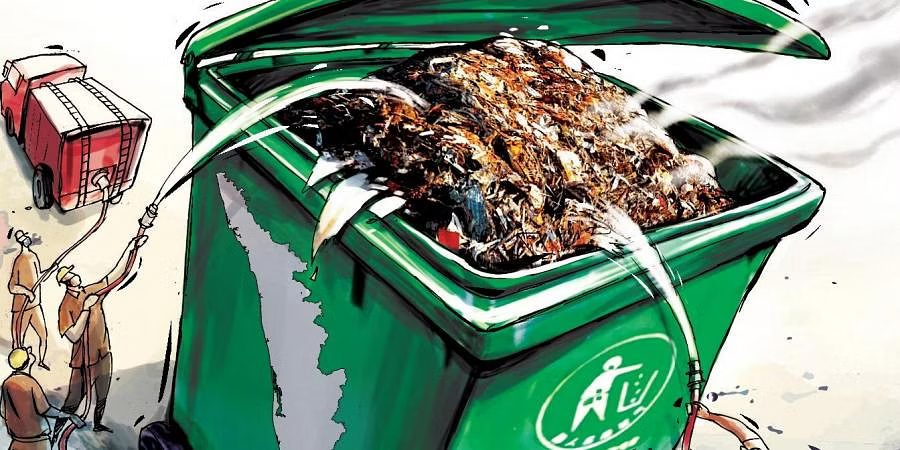
Dr T M Thomas Isaac
The dump yard fire happened because for whatever reason, Kochi did not follow the tested and proven methods that were being used in other towns in Kerala.
In the early 2010s, there was a spate of agitations in Kerala against urban waste dumping sites, most of which were located outside towns. The tradition was that waste from houses, establishments and street sweepings would be transported to these sites and dumped. An attempt was made to segregate the waste at the yards and windrow compost the organic waste. Private service providers set up BOT plants in these yards. But these centralised plants proved to be failures without exception. This crisis ignited the protests.
What went wrong? Failure to segregate at source became a major impediment for effective windrow composting. In most plants, waste was composted after preliminary sorting and then the compost was segregated from non-organic material through mechanical sieving. This resulted in a relatively longer duration for composting and frequent breakdowns of sieving machinery. In most places, the facilities for treatment of leachate proved to be inadequate. Almost everywhere, people around the plants physically blocked the movement of waste.
When the rural people raised the slogan “Not in My Backyard” (title of a book on solid waste management by Sunitha Narain and Swati Singh), all the dumping yards had to be closed. There was no choice other than for citizens to take responsibility and process the waste in their own backyards. Thus was born in the mid 2010s the movement for decentralised waste management in Kerala.
Decentralised waste management or processing waste at source does not imply that all waste can or needs to be processed at source. Decentralisation follows the principle of subsidiarity. All that can be done effectively at the household/establishment level should be undertaken there and only the rest must be taken to the next level.
Alappuzha town, one of the first towns to take up decentralised waste management, successfully demonstrated the effectiveness of small-scale community composting centres. Besides the traditional biogas units, several user-friendly kitchen bin compost models were innovated and are widely used today. The more traditional compost pits would be sufficient in rural areas. Most towns have also now set up windrow composting centres where excess waste from shops and community composting centres are processed. The best example is that of Attingal, where such a composting centre has been effectively functioning for the last two decades.
The non-organic waste is collected from households and shops by members of the green army for a user fee. Material collection centres are established for detailed segregation of non-organic waste before sale to vendors for recycling, reuse or landfilling.
There are significant variations in waste management between local governments. At many places, the green army also provides support and advice on waste management and measures to reduce waste. They can be organised in social enterprise mode with income from the user fee and supplementary income from sale of waste, inoculum products, alternative products and services. The best examples of the social enterprise mode of waste management are towns like Vadakara, Kunnamkulam and Guruvayur, which have demonstrated that waste management can be a profitable social enterprise.
Thalipparambu and Attingal municipalities have another variant where the centralised facilities are managed by small-scale private entrepreneurs. It is in the market for final disposal of non-organic waste where private vendors thrive. There is also a public Clean Kerala Company that often mediates between the private vendors. Already, 16 private plants to process slaughter waste are operational in the state. Without broad-based awareness and participation, this decentralised waste management is not possible. It was in recognition of this aspect that the state government launched the Haritha Keralam Mission to support local governments.
As a participant observer of the decentralised waste management movement in Kerala, I am saddened that the fire and fumes of Brahmapuram have cast a shadow of shame on the efforts so far towards a Clean Kerala. There are around 30 dumping yards in Kerala where legacy waste is yet to be cleared. The process is in different stages of completion. But there has not been any instance of fire in these sites other than in Kochi’s Brahmapuram.
Why? This is the key question. What makes Brahmapuram different? The movement of waste to all other dumping yards effectively stopped by the early 2010s. The old legacy waste mounts continued but there was no addition of fresh organic waste, which can generate methane and spark a fire. In contrast, the waste movement, that too non-segregated, to Brahmapuram, continued. The popular resistance was also weak because of the vast 115 acre-yard and its relative isolation.
Kochi never took to decentralised waste management mainly because of the high expectations of the waste-to-energy plant that was being planned for nearly a decade. Some of the senior bureaucrats in fact discouraged decentralised waste management, fearing that such a system, if successful, would undermine sufficient supply of waste to the plant.
In fact, a permissive order was issued to bring waste from neighbouring municipalities and panchayats in the district for dumping in Brahmapuram. There was a large windrow plant of the old model whose capacity was soon overrun by the non-segregated waste from not only the city but also from the rest of the district.
The Brahmapuram fire was a debacle that was waiting to happen. Now it is revealed that the fire was an annual happening. But nobody seems to have been worried as long as the fire was within manageable limits. But this time it went out of control with disastrous consequences.
The Brahmapuram waste yard imbroglio happened because for whatever reason, Kochi did not follow the tested and proven methods that were being used in other towns in Kerala. The fire has been the NIMB (Not in My Backyard) moment for Kochi. There is no option other than to adopt a decentralised waste management system, at least for the present. If there is any skeptic doubting the relevance of the best practices of small towns to a metropolis, my suggestion is to take a visit to Kozhikode in North Kerala.
(The writer is the Former finance minister of Kerala)





